The ‘Info Defense’ Network: Crowdsourcing Soldiers for the Information War
5 July 2022
By Elise Thomas
_________________________________________________________________________________
Introduction
Since the Russian invasion of Ukraine in February 2022, jurisdictions and tech platforms around the world have taken steps to prevent or limit the spread of Russian propaganda internationally. There is, however, an additional constraint hampering the efforts of Russia and its supporters in spreading disinformation: language.
This Dispatch investigates a coordinated network of volunteers working to translate existing Russian-language propaganda and disinformation about the war in Ukraine into over a dozen languages. This includes content from pro-Kremlin influencers, particularly the controversial Ukrainian blogger Yuri Podolyaka, as well as Russian state media sources. The volunteers, who have branded themselves ‘Info Defense’, operate Telegram channels for each of the target languages. They also administer specifically-branded Info Defense accounts on YouTube, and disseminate their content across the major international social media networks through a multitude of smaller accounts.
The significance of this network is at the base level in which it functions : a grassroots, relatively decentralised and cost-free network for the translation and distribution of propaganda. This model may appeal to both state- and non-state actors seeking to promote narratives and content to international audiences, and is likely to pose a challenge for platform content moderation efforts.
Origins – Yuri Podolyaka’s volunteers
The call for volunteer translators which birthed the Info Defense network came from Yuri Podolyaka, a pro-Russian Ukrainian blogger who has seen his audience and public profile skyrocket since Russia’s expanded invasion of Ukraine in February.
Podolyaka is a controversial political writer, blogger and YouTuber, and a long-time vocal supporter of Russia’s aggressive actions in Ukraine. He left Ukraine and moved to Russian-occupied Crimea in 2014 following the Maidan revolution. Since February 2022, Podolyaka’s social media following has experienced explosive growth despite having his main YouTube account removed by the platform. His main channel on Telegram, for example, had around 26,671 subscribers on 23 February. As of 15 June, it had over 2.19 million subscribers.

Image 1: Subscriber growth by day for Podolyaka’s ‘World Today’ channel, captured 15 June 2022.
Podolyaka’s content, which focuses on his strongly pro-Russian analysis and opinions of the war in Ukraine, consists of written pieces and filmed monologues in the Russian language. He aspires to extend his reach beyond Russia-speaking audiences.
On 28 February, the influencer posted on Telegram asking for help producing translations from his followers in response to an implied flood of requests for translations. On 3 March, he posted again on the topic of translations.
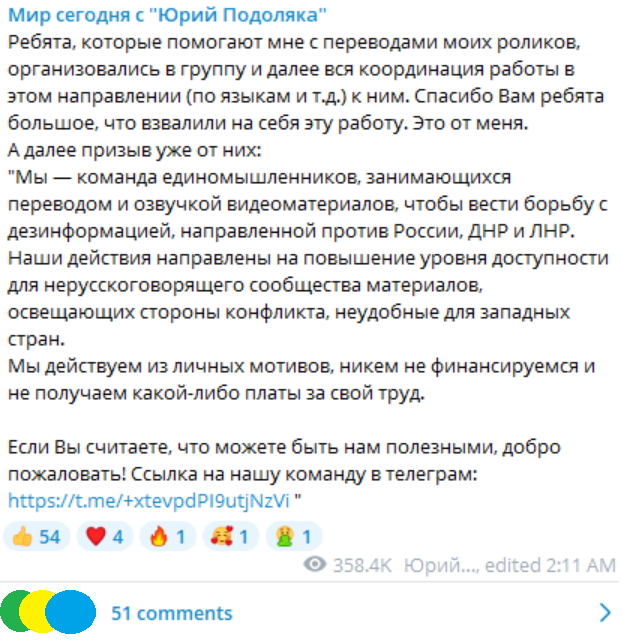
Image 2: Screenshot of a post in Podolyaka’s Telegram channel on 3 March, announcing the creation of a volunteer group of translators.
Podolyaka’s post read (see Image 2):
The guys who helped me with the translations of my videos organised themselves into a group and now all the coordination of work in this direction (in languages, etc.) will be directed to them. Thank you guys so much for taking on this job. This is from me [Podolyaka].
And then a call from them:
“We are a team of like-minded people involved in the translation and voice-over of video materials in order to combat disinformation directed against Russia, the DPR [Donetsk People’s Republic] and LPR [Lugansk People’s Republic]. Our actions are aimed at increasing the level of accessibility for the non-Russian-speaking community of materials covering the parties to the conflict, inconvenient for Western countries.
We act from personal motives, we are not financed by anyone and we do not receive any payment for our work.
If you think you can be of service to us, welcome!”
In a video message promoting the newly formed translation network, Podolyaka elaborated on the role which he saw himself and his supporters playing in support of Russia’s war in Ukraine. He spoke at length about the way in which media coverage and information about the war in Vietnam helped to deplete domestic support for the war in the US, ultimately leading to the US’s defeat and retreat from Vietnam. According to Podolyaka, if the public in Western countries only knew that Russia was really fighting against evil Nazis in Ukraine, they would force their governments to abandon the fight, as they did in Vietnam. “This is the truth that they want to hide from their societies, and our task is to bring this truth to them,” he said.
Podolyaka asked for volunteers to join the group, including native speakers of foreign languages, video editors and people to act as distributors by helping to share the content widely on social media or, if possible, getting it into foreign media outlets. Podolyaka emphasised the voluntary nature of the network and that no one would be paid for their efforts.
The influencer has also alleged that he had been in discussions with Russian state media outlet Russia Today about some form of collaboration between RT and the Info Defense network. However, he later communicated that the deal fell through because RT wanted to provide funding in return for control over Podolyaka’s content. Podolyaka claims that RT then just tried to copy their idea.
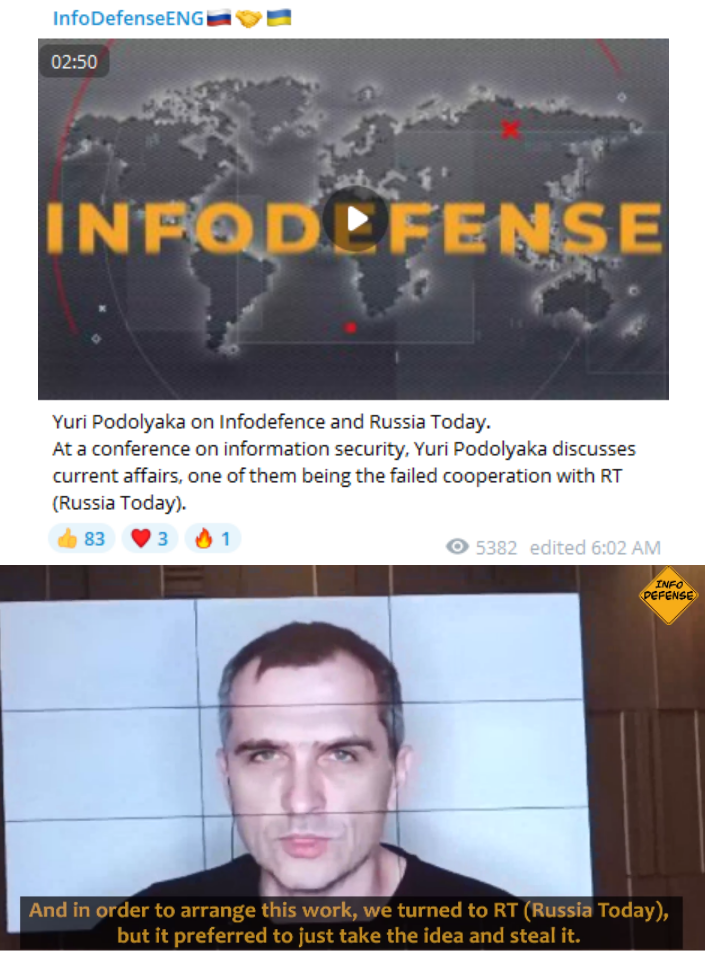
Images 3 and 4: Screenshots of Info Defense Telegram post and subtitled video of Podolyaka discussing the failed collaboration between Info Defense and RT.
On 22 April, Margarita Simonyan, editor-in-chief of RT, posted in her Telegram channel promoting translations of RT’s videos. Without making any mention of Podolyaka or Info Defense, Simonyan encouraged her followers to join the ‘People’s Information Militia’ and share the translated videos with their non-Russophone friends and family. While RT does not appear to have adopted the volunteer-led model for doing the translation work, this effort does seem to echo Info Defense’s method of volunteer content distribution.
Among Podolyaka’s original network of supporters, the volunteer propaganda efforts continue to evolve. There appears to be a high degree of crossover between the Info Defense network and other networks linked to Podolyaka– in particular a very similar Telegram network called The Eye of the Storm (TEOS) and another fledgling network called The Node of Time. It is not clear whether the same group of volunteers is behind all of these accounts and Telegram channels, or whether these are separate but cooperating groups. The TEOS network and The Node of Time will therefore also be briefly discussed in this report.
Info Defense’s Content
Info Defense’s content consists primarily of Russian-language video clips, but occasionally international media clips are also translated where they are in line with Russian talking points, or promoting anti-Western sentiment.
The Russian-language clips are taken from a range of sources and dubbed or subtitled into other languages. In addition to Podolyaka’s videos, other video sources include Russian state media and pro-Russian Telegram channels. The dubbing seems to be done by human speakers, not by AI (unlike, for example, the pro-CCP Spamouflage network which does use AI dubbing).
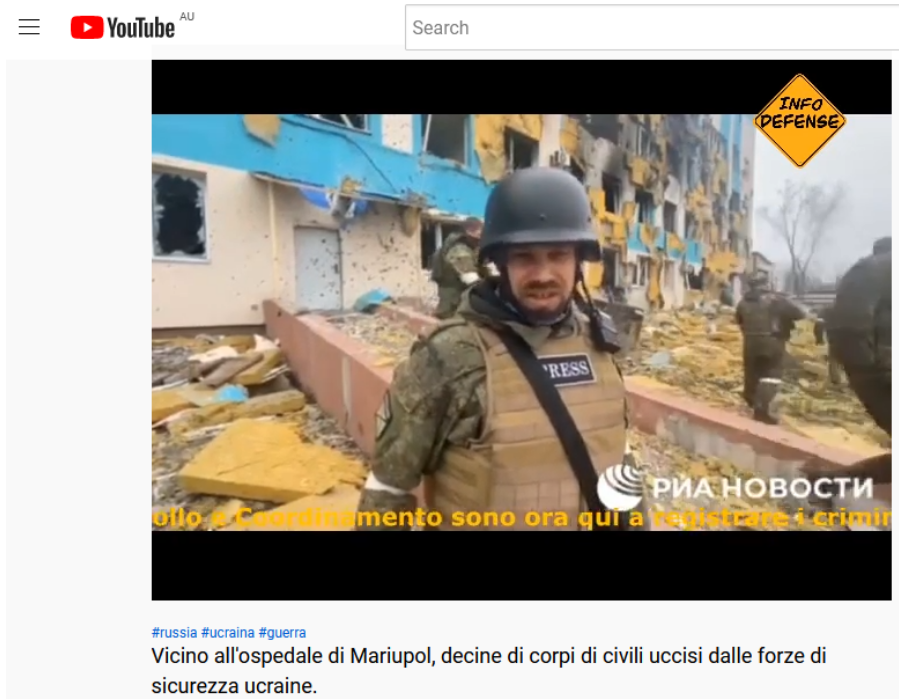
Image 5. Screenshot of Info Defense YouTube video, dubbing and subtitling a clip from Russian media outlet Ria Novosti into Italian.
Additionally, video clips from international sources (promoting views which the Info Defense volunteers presumably believe are favourable to Russia) are also used. Below, for example, the Info Defense Japanese channel has subtitled a clip from controversial US television host Tucker Carlson.

Image 6: Screenshot of Info Defense translation of a Tucker Carlson clip.
Subtitles are usually added in yellow, matching the yellow Info Defense watermark in the top-right corner.
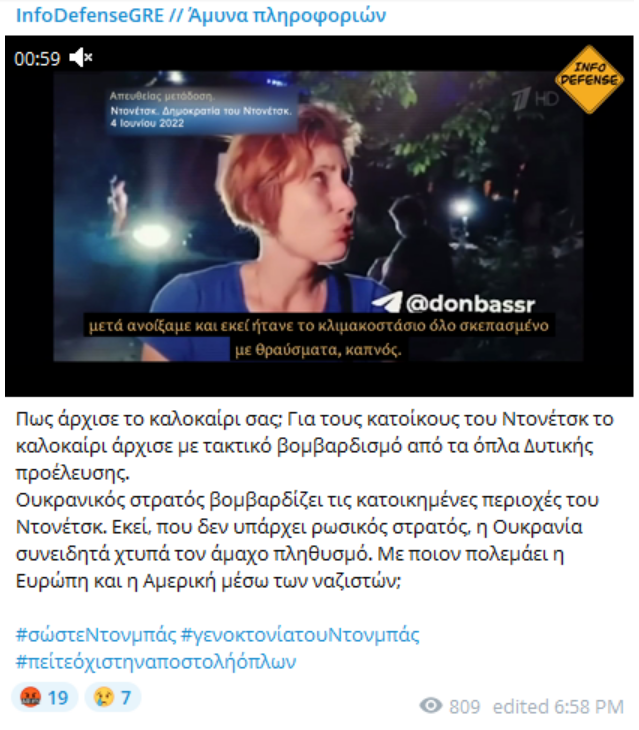
Image 7: Screenshot of Telegram post in Info Defense’s Greek-language Telegram channel, showing a clip taken from pro-Russian Telegram channel @donbassr. The clip has been subtitled in Greek by Info Defense and the Info Defense watermark has been added.
A brief opening credit sequence is also added, showing the English word “Info Defense” emblazoned in yellow across a grey world map.
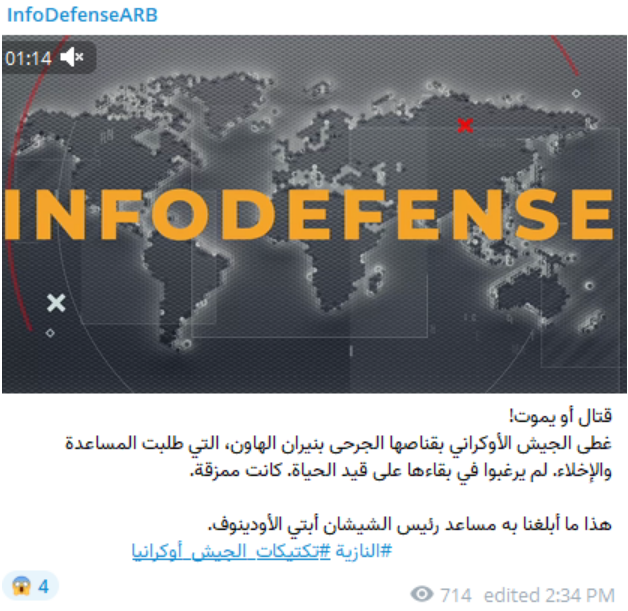
Image 8: Screenshot of Info Defense Arabic video, showing opening credit sequence.
The network’s Telegram channels also occasionally share articles from international media sources which appear to reflect anti-US, anti-Ukrainian or anti-Western sentiment, or which highlight division in the international community’s support for Ukraine.
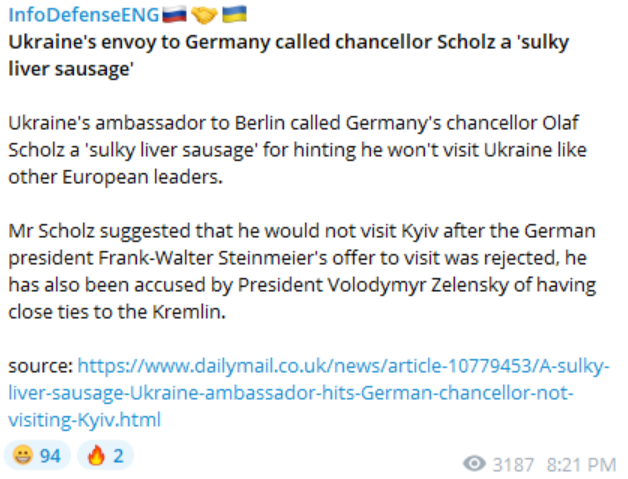
Image 9: Screenshot of a post in Info Defense’s English-language channel, sharing a Daily Mail article about friction between Ukraine and Germany.
As of early July 2022, Info Defense’s content has been limited to translations; the network does not appear to be producing any original content. However, some recruitment posts suggest that they may have ambitions to produce original content in the future.
Operations
Distribution
As of 16 June, the Info Defense network consists of at least 17 language-specific Telegram channels (Russian, English, German, French, Italian, Spanish, Portuguese, Turkish, Bulgarian, Chinese, Greek, Polish, Serbian, Slovakian, Arabic, Lithuanian and Japanese) and 6 YouTube channels (in English, German, Slovakian, French, Italian and Spanish).
Activity levels vary significantly between different language channels. For example, while the English-language channel circulates content almost every day and sometimes multiple times a day, the Turkish language channel has been inactive since 4 June. This disparity likely reflects the availability of volunteer translators for the different languages.
There are also significant variations in the number of subscribers to each channel. Perhaps unsurprisingly, the largest channel is the Russian-language Info Defense channel with 15,871 subscribers as of 21 June. The English-language channel is about half the size, with 7,883 subscribers, while the Hebrew channel is the smallest with just 35 subscribers. Collectively as of 21 June the channels have 50,062 subscribers on Telegram (although the number of unique subscribers may differ, for example if some users are subscribed to more than one Info Defense channel).
However, it is unlikely that this represents the entire footprint of the network. The volunteer nature of the network makes it difficult to establish exactly how many accounts are involved in sharing content without adopting the Info Defense branding in the name or description of the account. Additionally, it appears that some volunteers have also set up their own accounts for distributing content separately from the official Info Defense channels. This decentralised model of content distribution is a key part of the concept behind the Info Defense network, making its true scale very difficult to track.
For example, while there is a branded Info Defense English-language YouTube channel (which frequently uses a blue and yellow colour scheme, perhaps in an effort to draw in viewers with pro-Ukrainian views and attempt to have them reconsider their stances), the same content is also shared by smaller, unbranded accounts which appear to have been used primarily to publish Info Defense content.
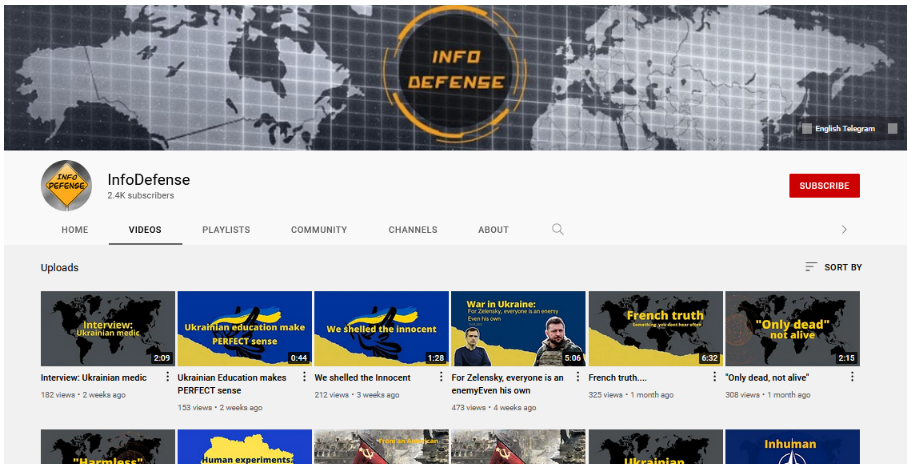
Image 10: Screenshot of main Info Defense English-language YouTube channel.
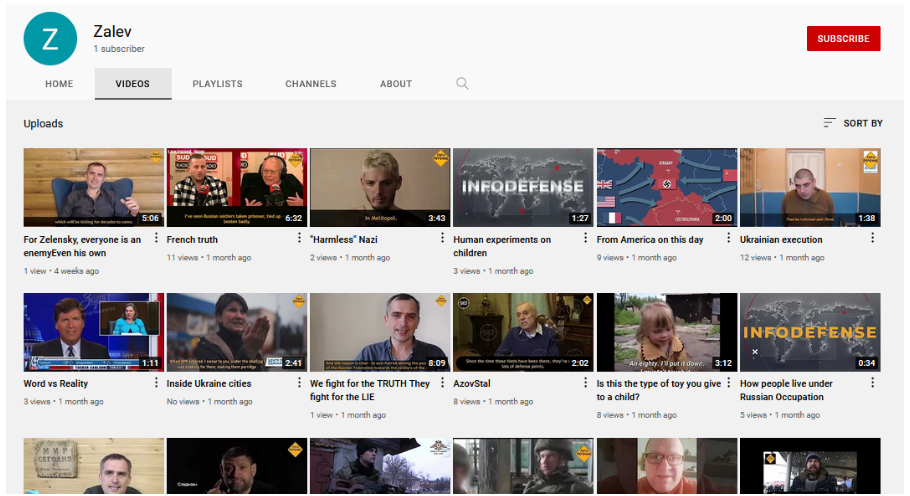
Image 11. Screenshot of small YouTube account used for sharing Info Defense content.
The network also has a small presence on Facebook including a branded Info Defense account, but with only 13 followers as of 22 June. An Info Defense account was created on Twitter but appears to have been taken down (it is unclear whether it was removed by the network themselves or by Twitter).
Interestingly, however, a Russian diplomatic Facebook page has shared Info Defense’s content from Telegram. According to CrowdTangle data, the Embassy of Russia in Bangladesh’s Facebook account has shared Info Defense videos at least six times between March- and May 2022. One of these posts, containing debunked disinformation about the massacre in Bucha, was then shared by the Russian Consul General in Osaka.
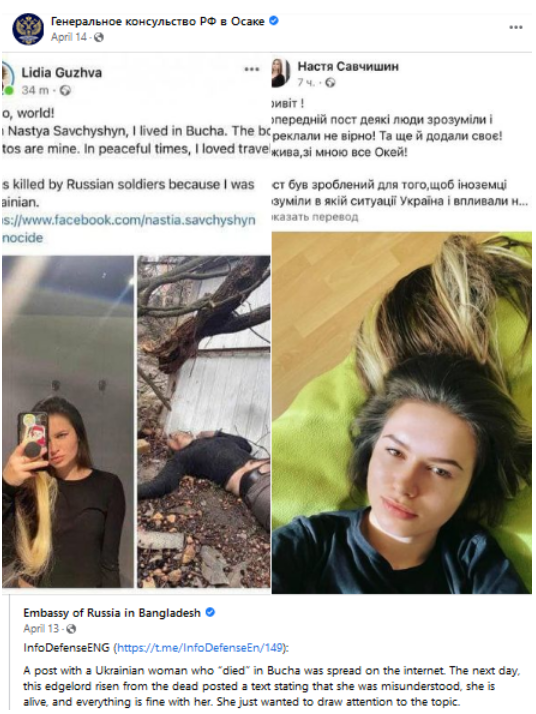
Image 12: Screenshot of Facebook post by the Russian Consul General in Osaka, sharing a post by the Russian Embassy in Bangladesh which links to a post in the Info Defense English-language Telegram channel.
Podolyaka and the Info Defense volunteers have repeatedly emphasised the importance of targeting Western and international fringe media and influencers as a key part of their strategy. They appear to be achieving a degree of success with this.
For example, Russian-based Canadian blogger Eva Bartlett (who has played a key role in promoting pro-Russian conspiracy theories about the Syrian conflict and is currently participating in Russian propaganda exercises linked to the war in Ukraine) has shared Info Defense’s English-language content at least five times to her 19,000 followers on Telegram.
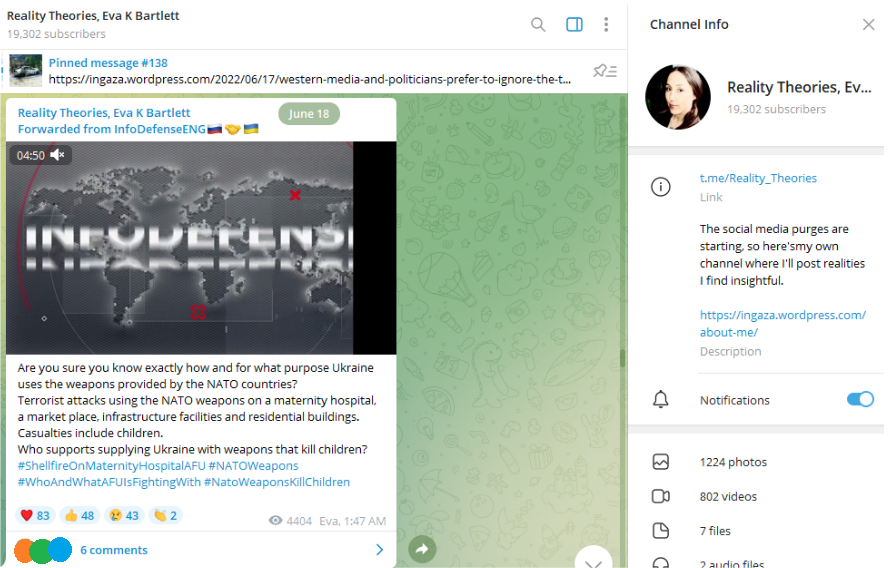
Image 13. Screenshot of Eva Bartlett’s channel, showing a shared post on 18 June from the Info Defense English channel.
Similarly, Info Defense appears to have made some inroads with the German influencer Alina Lipp, who has previously shared pro-Kremlin content. Lipp has used her Telegram channel to share Info Defense content at least four times since March 2022. The Info Defense network has also translated some of Lipp’s content into other languages.
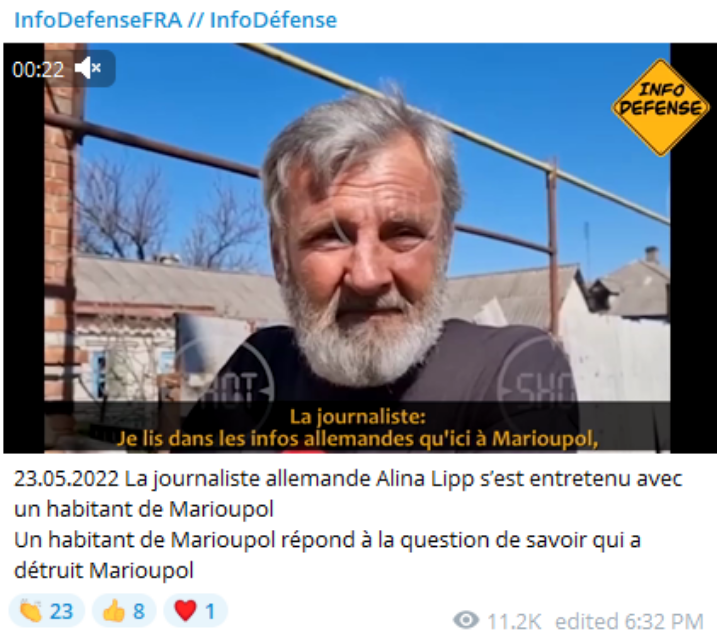
Image 14: Screenshot of post from Info Defense’s French language channel, sharing a translated version of Lipp’s content from Mariupol.
Recruitment
A post written by the Info Defense volunteers and published on 23 April on the site Our Truth, which is linked to Podolyaka, outlined the goals of the network. The authors wrote, in part, that:
“We are a team of volunteers who translate materials that official media will not show in pro-American countries. We act from personal motives, we are not financed by anyone and we do not receive any payment for our work – this is the main thing that makes us invulnerable. We encourage you to copy and distribute the submitted materials on all resources available to you. Above all, independent Western media is important.”
The network regularly solicits more volunteers in a range of languages. Earlier recruitment drives appear to have received enthusiastic support. A post asking for volunteers on 20 March garnered 107 replies, most of which were Telegram users volunteering themselves to help in a range of languages.
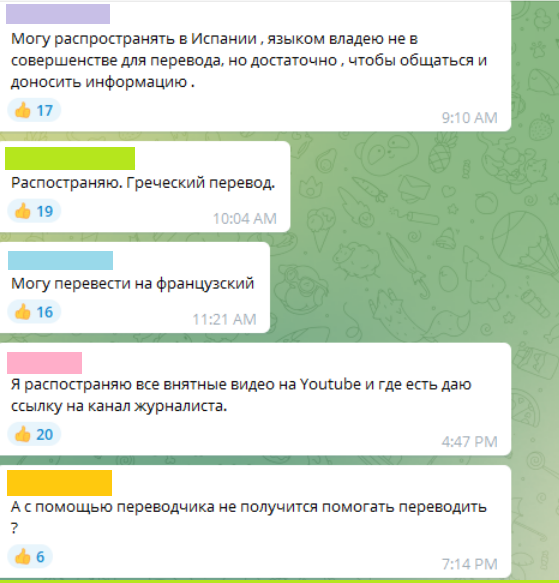
Image 15. Screenshot of some of the replies to a recruitment post on 20 March.
As of at least 19 May, the network appears to be making a particular push on developing their English-language volunteer cohort. A recruitment post from that date only asks for translators and dubbers/voice actors for most other languages, while for English they state that: “We are aiming towards a new milestone in the development of the English direction. There is an urgent need for translators, copywriters, journalists, speakers with a good command of the language, native speakers who understand Western audiences and are able to select news from foreign and Russian sources.” (translated from Russian).
Posts on their English-language Telegram and Facebook channels also solicit volunteers for a wider variety of roles than just translation. They ask for a six-month commitment of a minimum of 3-5 hours per week, depending on the role.
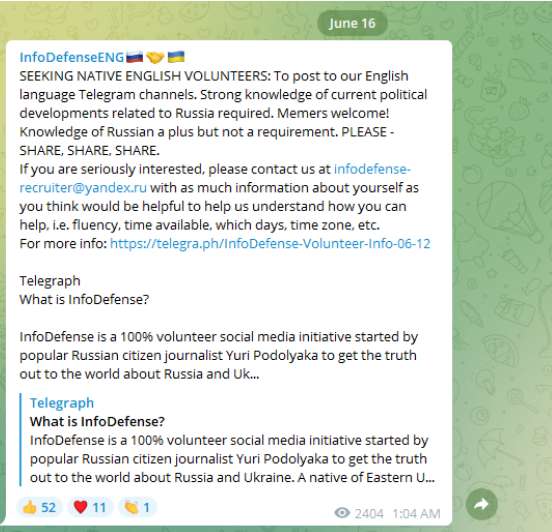
Image 16: Screenshot from InfoDefenseENG Telegram channel, seeking native English speakers to work as volunteer translators.
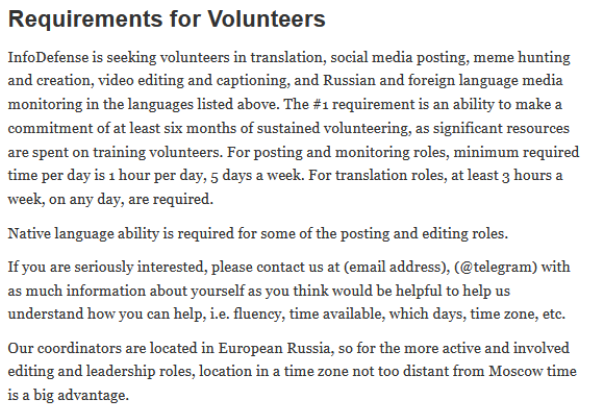
Image 17. Screenshot of Telegraph post dated 12 June laying out requirements for English-language volunteer translators.
The Info Defense network’s English-language content does not appear to have significantly changed since 19 May. It may be that they are still recruiting, or they may be channelling the additional volunteers into a separate ‘brand’, for example, The Node of Time.
Related networks – The Eye of the Storm and The Node of Time
On 27 March, Podolyaka posted in his own channel promoting the volunteer translation initiative and sharing the recruitment email address for Info Defense. However, instead of linking to the Info Defense channels, Podolyaka linked to an apparently separate network of channels in multiple languages. One of these channels was branded as ‘The Eye of The Storm’ (TEOS). The TEOS channels had been created a few days earlier, around 25 March.
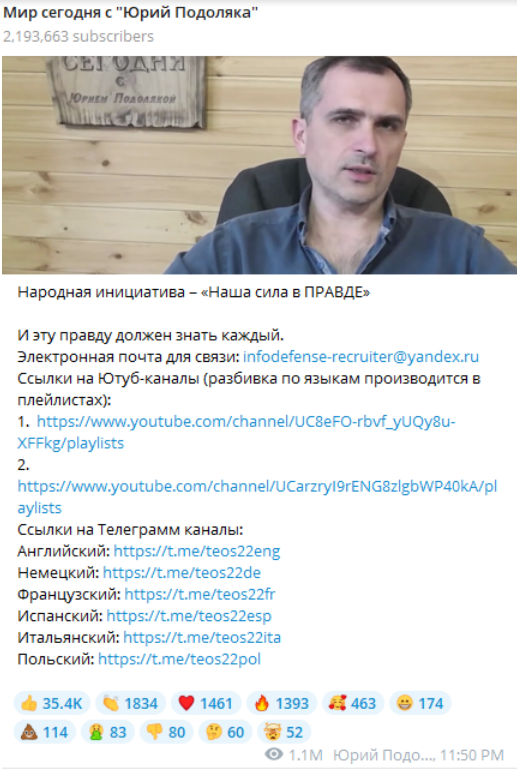
Image 18: Screenshot of a post in Podolyaka’s channel, dated 27 March.
The TEOS channels appear to have cooperated very closely with the Info Defense network. It is not clear whether they are run by the same group of volunteers or separate groups working in collaboration. The TEOS channels refer to the Info Defense channels as ‘friendly channels’ and frequently shared Info Defense branded content. However, all TEOS channels have been inactive since 29 April, as of 21 June.
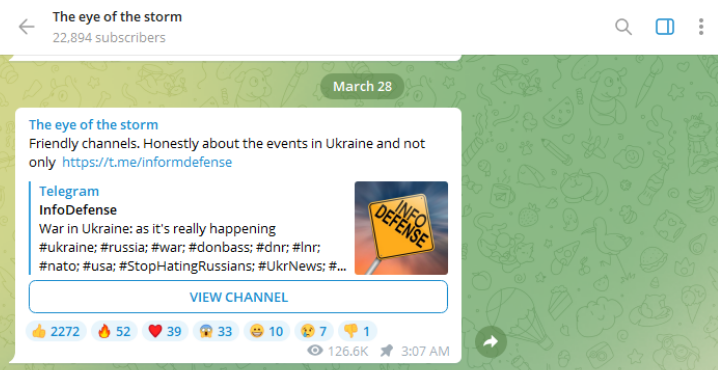
Image 19: Screenshot of a post in TEOS English-language channel, referring to the Info Defense network as ‘friendly channels’.
On 29 May, a third very similar network of Telegram channels was created. This network, called The Node of Time, has been described by other Telegram channels as “sponsored by Yuri Podolyaka”. As of 22 June, it has only a small following across its multiple channels.
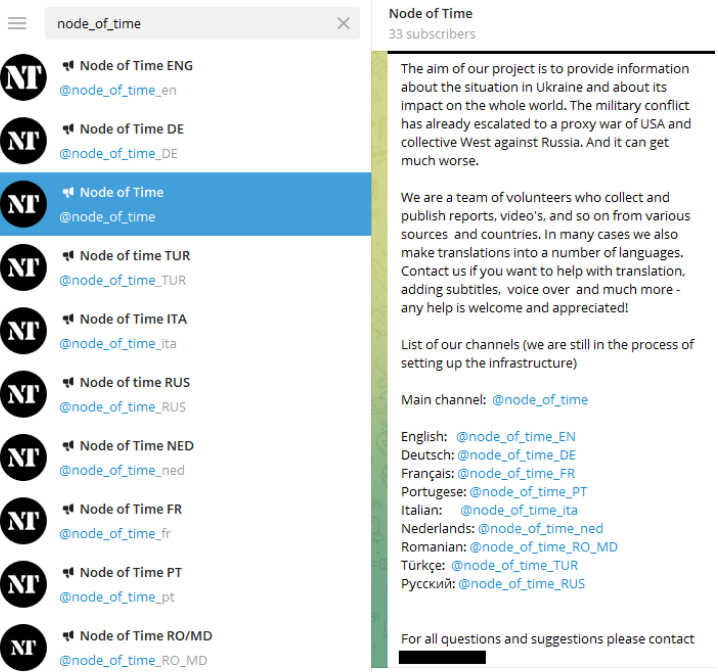
Image 20: Screenshot showing Node of Time Telegram channels in multiple languages.
Introductory posts in the Node of Time Italian and Dutch channels refer to a direct link between Node of Time and Info Defense, but also suggest a possible rupture or dispute between the volunteers. The Italian post states that:
“Our channel was first created as part of the InfoDefenseITA project. Unfortunately, we have been forced, along with a number of other channels, to split up to work better and more efficiently. In doing so, we have lost control of our channels and our subscribers. The videos that were made during the period under “InfoDefenseITA” are mainly our work, so we publish these videos as they are on this new channel.” (auto-translated from Italian).
The Node of Time channels also post pro-Russian and anti-Western content from a range of sources, but with more focus on commentary than on translation. The subscriber counts on the Node of Time channels are very low (200 followers or less per channel) as of 27 June.
Discussion
Over time, the significance of Info Defense may prove to be less in the network itself and more in the model which it demonstrates: a grassroots, decentralised and no-cost mechanism for distributing existing propaganda to international audiences. It demonstrates a method of crowdsourcing soldiers for the information war — for free.
This model may prove to be of interest both to influencers and media figures like Podolyaka who are seeking to expand their reach and grow their audience, as well as to state and state-linked actors. Indeed, if Podolyaka’s claims about Russia Today are correct, Russian state-linked influence peddlers have already demonstrated an interest in the Info Defense model.
The model is also likely to pose a quandary for content moderation efforts. Following Russia’s invasion of Ukraine in February 2022, major social media platforms including Facebook, YouTube and Twitter imposed measures to ban, restrict or flag Russian state media content to users. The Info Defense network sidesteps those measures, distributing Russian state-owned media content through small-scale, decentralised accounts and with changes which may conceal both from platforms and from audiences the content’s origins (the Info Defense logo is often placed over the top of the RT logo in video clips, for example. It is not clear whether this is a deliberate effort at concealment or whether they simply both like to place the logo in the top right corner).
It is also not clear whether the Info Defense network’s activity would be sufficient to trigger platforms’ existing policies targeting covert information operations. Facebook’s Inauthentic Behaviour policy, for example, bans the use of fake accounts, misleading users or “coordinated inauthentic behaviour.” The behaviour of the Info Defense network is (loosely) coordinated, but it is not obvious that it qualifies as inauthentic. It supports the interests of the Russian state and promotes Russian state propaganda, but so far there does not appear to be evidence of direct intervention or coordination by state actors. The grassroots, decentralised propaganda model demonstrated by Info Defense may therefore prove to be a significant challenge for platforms to develop a response against, both on a policy and a technical level.
Elise Thomas is an OSINT Analyst at ISD. She has previously worked for the Australian Strategic Policy Institute, and has written for Foreign Policy, The Daily Beast, Wired and others.




